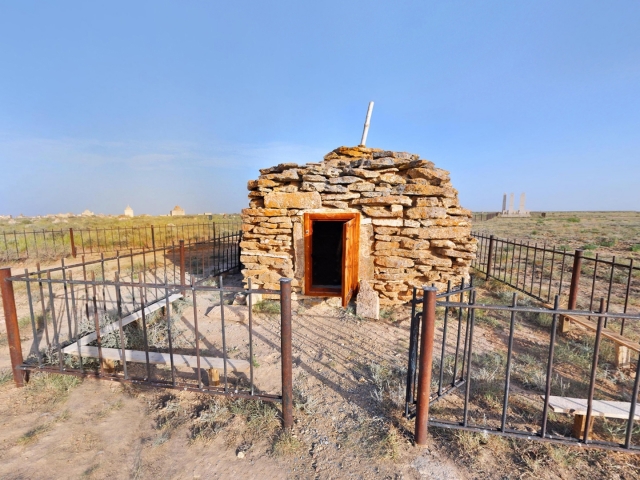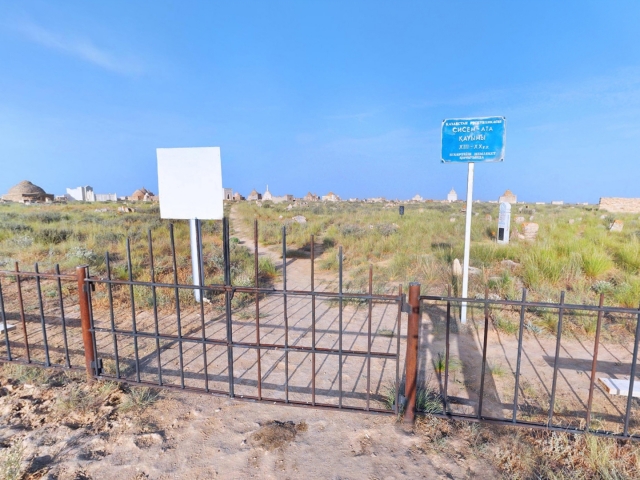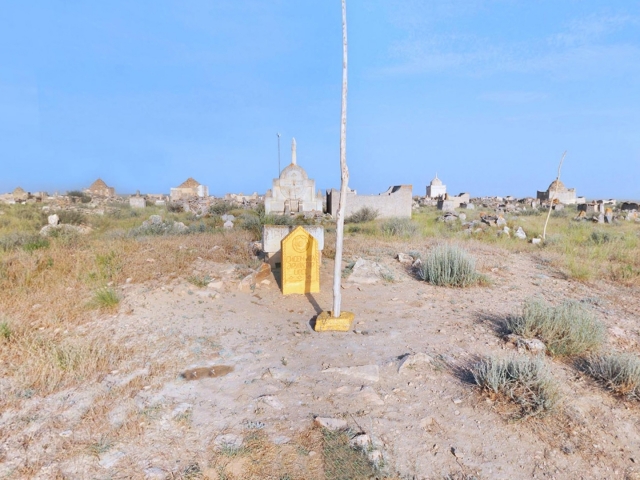Places
List of objects included in the map
Sissem-Ata Necropolis
Location: located in Mangistau district of Mangistau region, 35 km to the north from Otess village.
Coordinates: N 44°37' 15.36" , E 53°34' 50.10"
Description of the Monument: The monument was first taken under the state protection upon Resolution no. 38 by the Council of Ministers of the Kazakh SSR dated 20.01.1982. By Order of the Minister of Culture and Sports of the Republic of Kazakhstan no. 119 dated March 30, 2015 the memorial was included in the governmental list of historical and cultural monuments of national importance. Resolution No. 414 of the Akimat of Mangistau region dated 08.12.2010 approved boundaries of the protected areas. Research and restoration works were carried out in the Sissem necropolis in 2006, 2007, 2008, 2009, 2010, 2017. Sissem-Ata necropolis was studied by expeditions of the RoK Ministry of Culture in 1977 under the leadership of A. O. Etenov, in 1979 under the direction of M. Nurkabaev, in 1988 under the leadership of T. D. Zhanysbekov together with a group of architects from Institute 'Kazproektrestavratsiya'. In October 2012 an expedition for exploration of the necropolis and its historical and cultural environment took place under the guidance of Serik Azhigali Doctor of Hystory, Professor of Ualikhanov Institute of History and Ethnology. Sissem-Ata necropolis is a valuable source for the history, ethnography and the history of architecture of Mangistau. Sissem-Ata necropolis is one of the largest and most ancient necropolis in Mangistau; it is located on the western cliff of the Ustyurt Plateau, in the flat landscape of semi-desert near the ancient caravan route, wells and winter grounds. Archaeologist Alan Medoyev wrote: 'Sissem-Ata necropolis is the place where the period of formation of the first people Mangistau passed'. The main complex is arranged around the tomb of Sissem-Ata. Among other ancient sites Sissem-Ata necropolis stands well-preserved with monuments created by inspired work of such craftsmen as Zhylkybai Doralyuly, Turlymurat Satybaldyuly, descendants of master Sakha (Duisenbai, Ordabai, Yense, Kozybak), etc. Sissem-Ata necropolis is a rare complex of monuments with memorial and religious architecture and stone carving art. It is not coincident that in this necropolis there is a large number of helmet-shaped graves. This shape appeared in a stone sculpture at the time of foundation of the necropolis, and noted the grave of a hero, who died during the war in 14th century. Along with tribal tamgas of the junior zhuz Baiuly, tamgas of Zhetiru and Alimuly tribes are found here.
Historical Data, Legends and Stories: In written sources Sissem-Ata is for the first time mentioned in the report of the first Russian military recognition expedition in 1825-1826 under the leadership of Colonel F. Berg. The brief log entry about the necropolis says: 'It is a sacred cemetery that consists of several cone-shaped stone and earth mounds, but there is no information how ancient they are; judging by their integrity we must assume that they belong to the Turkmens or the first Kyrgyz here'. According to studies of M. Mendikulov the time of burial is dated 11th-12th centuries. There are quite a lot of different symbols and traditional patterns depicted on the tomb and oriented from the north to the south. They illustrate political events in Kipchak-Nogay period. According to oral tradition, Sissem Ata was one of Islamic preachers who lived in the middle ages in the Oguz-Kipchak period. According to one of such legends, Sissem Ata blessed Kazakh Adai clan to accommodate this area. Therefore, after the death of Sissem-Ata, the burial place of the saint turned into the graveyard of the Adai clan, and further around his mausoleum a necropolis of Adai warriors was established. The Kazakh people had a tradition to bury the deceased in holy places. Data is available that such batyrs of Adai clan are buried here as Suyunkar-batyr, Urgeshbaiuly, Tulep-batyr Anetuly, Konai-batyr Kenzheuly, Zhetimek Zhanuzak-batyr who devoted their lives to the struggle against the Khivan khans and other invaders, Kozhanazar bai Zhanaiuly, Yeskeldi Sanasar bai Kudainazaruly, Begei Dauldyr bai Kozybakuly, Sengir mirza Dauldyruly, Zharylgap bai Sengiruly, Seyit bi Yesseuly, Anet-bi Tekeiuly, Tolepuly Mambetniyaz bi, Baibos Bokkarauly, sons of the famous clan founders Zharyuly Nazar (Shotan-batyr, Tastemir bai Mailan, Kudaibergen), Zhanbos (Matai, Oteuly, Zhamankara), Sorbaiuly Otegul, Karzhau, Tolekeuly, etc.
Sissem Ata is considered the Pantheon of batyrs. On a small hill located in the western part of the necropolis there is a small grave called 'Az Aulie' this place is thought to be the grave of the mother of the holy Sissem-Ata. The Kazakhs have always respected the spirits of their ancestors. The locals have tradition of making sacrifices to spirits of the deceased; this resulted in a special ritual of visiting the necropolis of Sissem-Ata: before visiting the tomb of the saint it was necessary to visit to Az Aulie graveyard. Necropolis as a monument of history and culture occupies a significant place in patriotic education among younger generation through the spirits of warriors who gave their lives for freedom and independence of the Kazakh people.
Sources:
1. 'Monuments of Folk Architecture in Western Kazakhstan' by M. Mendikulov. Alma-Ata: Oner, 1987;
2. 'Epigraphy of Arabic Inscriptions at Sissem Ata Necropolis' by A. K. Muminov, A. Sh. Nurmanov, N.A.Kulbayev ' Astana, 2015;
3. Archives of Mangistau National Historical and Cultural Reserve.
Views: 2642
Video
3D Модель
Маршрут
Sultan-Epe Underground Mosque
Otpan Tau Historical and Cultural Complex
Oglandy Ata Burial
Becket-Ata Underground Mosque in Oglandy (18th-19th centuries)
Mynkissi Ata Complex
Massat Ata Necropolis and Underground Mosque (10th–19th centuries)
According to legend, the necropolis is associated with the 'saint' who came here from Mashhed (hence the name of the necropolis) during the Kalmyk invasion. Massat Ata had iconic status both among the Kazakhs and the Turkmen. He had the reputation of a batyr who fearlessly defended his land from invaders. ...














